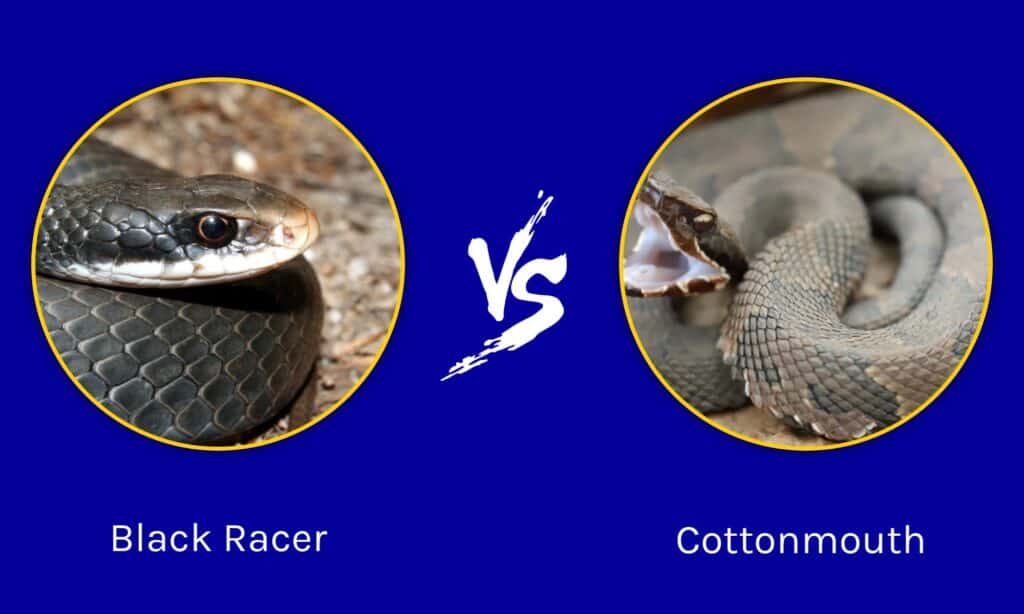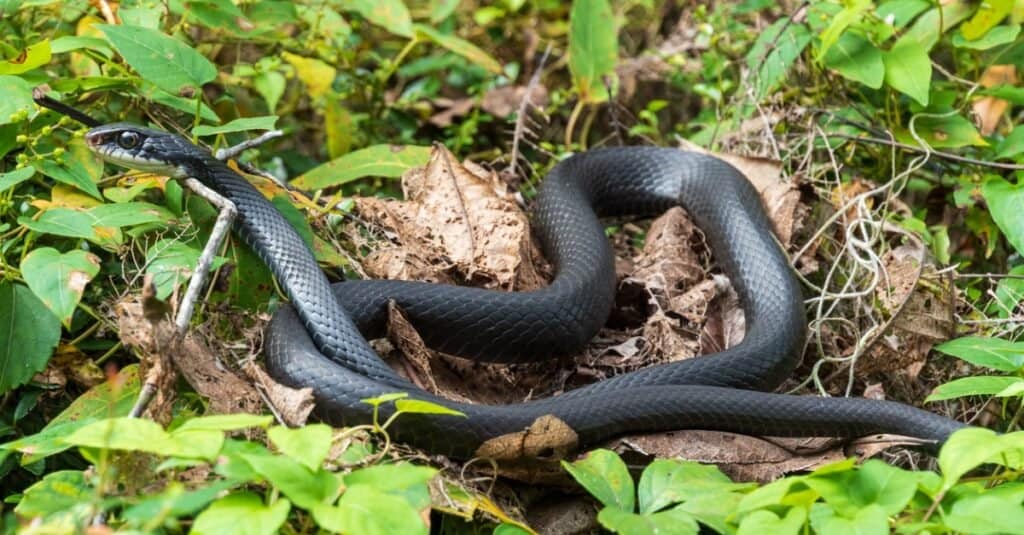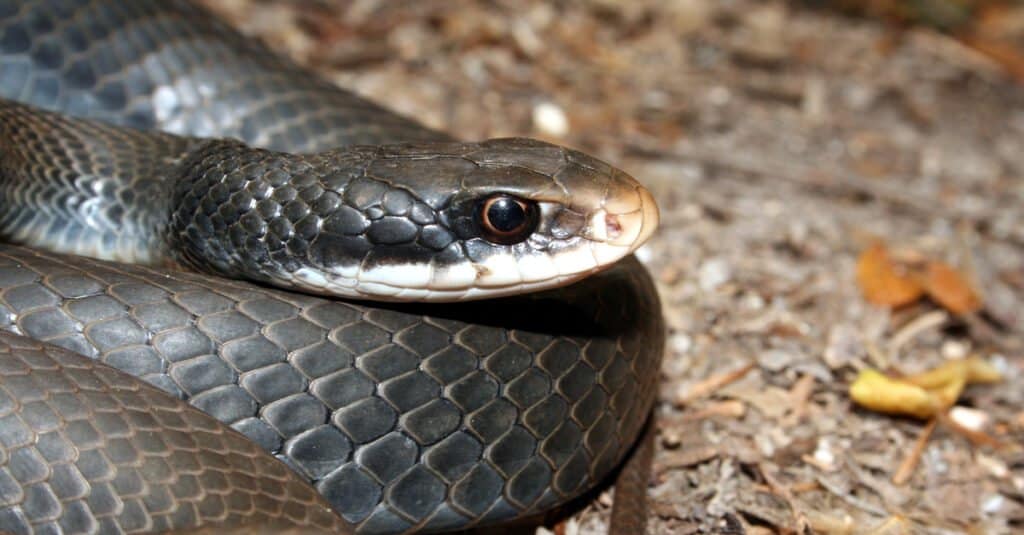Black Racer Snake vs Cottonmouth
Key Points
- Despite being pretty venomous, cottonmouths are not generally deadly to humans. Non-venomous black racers are comparatively harmless to people.
- Cottonmouths actively hunt at all hours of the day and night, whereas black racers only hunt during the daytime.
- Cottonmouths can be various shades of brown, and black racers are all black with some markings.
The United States is home to many species of snake. In the eastern half of the country, you can find snakes of one species or another just about anywhere you go. This is especially true for two of the eastern United States’ most common species of snake; cottonmouths and black racers.
Like all snakes, cottonmouths (Agkistrodon piscivorus) and black racers (Coluber constrictor) are ectothermic, meaning they need the sun to warm their bodies. They both eat their food whole, and prey on many of the same species. And, they occur in many of the same regions and habitats, leading some to confuse the two species for one another. Cottonmouths and black racers may eat many of the same things, and live in many of the same places, but only one of them can inflict a dangerous bite to humans.
Here, we’ll learn how to tell the difference between a cottonmouth and a black racer. We’ll start by analyzing their distinct appearances, then go over the preferred habitats of each species. Then, we’ll take a look at each snake’s behavior, and what they eat. Finally, we’ll explore which species is venomous, and which presents the greater threat to humans.
Comparing Black Racers vs. Cottonmouth Snakes

A-Z-Animals.com
| Black Racer | Cottonmouth | |
| Appearance | Thin with a narrow head | Larger with a heavy body |
| Habitat | Across the majority of America. Lives into Maine on the East Coast and found across the Rockies on the West Coast | Mostly confined to the South, enjoys living near aquatic environmnts. |
| Behavior | Only hunt during the day | Are opportunistic hunters that will look for prey day and night |
| Diet | Smaller prey that includes small mammals, eggs, amphibians | Larger prey that can include fish, crayfish, snakes, baby alligators |
| Venom | Non-venomous | Venomous |
The Key Differences Between Black Racers and Cottonmouth Snakes
The most important difference between black racers and cottonmouth snakes is that cottonmouth snakes are venomous while black racers are non-venomous. Beyond that key difference, black racers are thinner wiith a more narrow head and cottonmouths live in more aquatic habitats. Let’s dive into all the differences between these two snakes in more detail.
Black Racer Snake vs Cottonmouth: Appearance
Cottonmouths are widely known as water moccasins, whereas black racers are alternately known as North American racers, or simply racers. The biggest visible difference between the two is in the heaviness of their bodies. Where water moccasins are large, heavy-bodied snakes with big heads, black racers are thin, graceful snakes with narrow heads.

iStock.com/Sunshower Shots
As their name suggests, adult black racers are almost entirely black, or bluish-black. They have white markings on their chins and throats, and red eyes with round pupils. Young racers, however, have gray scales with distinct orange splotches. In contrast, cottonmouths range from yellow-brown to red-brown, and generally have diamond-like patterning. Water moccasins tend to grow darker as they age, but never gain the all-black look of racers.
Black Racer Snake vs Cottonmouth: Habitat
While black racers can be found as far north as southern Maine, cottonmouths prefer life in the south. They occur mostly in lowland areas no farther north than Virginia. Both species extend as far west as eastern Texas.
Locally, cottonmouths prefer moist environments with at least a seasonal supply of freshwater. They’re most common in swamps and floodplains, or near rivers and lakes. Black racers, in contrast, have little preference when it comes to habitat. They make themselves at home everywhere from mountainous zones to flatlands to the edges of urban areas. Racers are extremely common, and people often encounter them just outside of towns and cities.
Black Racer Snake vs Cottonmouth: Behavior
Black racers and cottonmouths have very different ways of birthing their young. Female black racers lay between 1-36 eggs during the summer, they hatch in the late summer or early fall. In contrast, cottonmouths actually keep their eggs inside their bodies. The eggs hatch inside the females, who then give birth to live young snakelings. Neither species provides much parental care after that, and many young snakes never make it to adulthood.

Jay Ondreicka/Shutterstock.com
Another characteristic setting these two species apart is their active hunting hours. Water moccasins are opportunistic hunters who will take prey at any time of day or night. Unlike cottonmouths, black racers only hunt during the day, they’re known as diurnal snakes. Further, black racers actually vibrate the tips of their tails to mimic rattlesnakes, something cottonmouths don’t do.
When threatened, black racers are much more likely to flee than are cottonmouths. Their impressive speed and their ability to climb trees make escape an effective strategy for the black racer. When people encounter a black racer, it will most likely make a run (or slither?) for it, but when attacked or cornered, it can deliver a nasty but non-venomous bite.
While the black racer slithers away, the water moccasin will actually stand its ground, baring its open mouth to its attacker. This is where the cottonmouth gets its name, from the snowy white interior of its mouth.
Black Racer Snake vs Cottonmouth: Diet
Both black racers and cottonmouths enjoy varied diets. Both species hunt for prey on both land and in the water, though the black racer, being a smaller bodied snake, is limited to smaller prey. Water moccasins eat fish, crayfish, amphibians, reptiles, smaller snakes, turtles, birds, rodents, turtle eggs, and baby alligators. Black racers also eat fish, amphibians, smaller snakes, reptiles, and turtles, in addition to birds, bird eggs, and insects.
When it comes to hunting, both cottonmouths and black racers employ two different, opportunistic methods: ambush, and active foraging.
Black Racer Snake vs Cottonmouth: Venom
Though you don’t want to get bit by either species, a bite from a cottonmouth is much more serious than a bite from a black racer. Why, you ask? Well, the cottonmouth doesn’t just have a sparkling white mouth, it also has large, hollow fangs connected to double venom glands in its cheeks. Inside those venom glands lies the water moccasins’ secret weapon: hemotoxic venom capable of killing small animals in minutes.

Psychotic Nature/Shutterstock.com
So, while the cottonmouth uses venom to kill its prey, the black racer, being venomless, is forced to rely on other means of incapacitating and killing. For black racers, the name of the game is in overpowering their prey. Cottonmouths simply strike and bite, then back off and wait for the creature to die. Black racers, however, have to force their prey to the ground, where they either slam it into something hard, or suffocate it to death.
Black Racer Snake vs Cottonmouth: Which is More Dangerous?
If you’re afraid of snakes, you’re probably afraid of black racers and cottonmouths, regardless of the fact that only one of them is venomous. Cottonmouths are far more dangerous than black racers, but, they’re still extremely unlikely to kill a human. For both species, bites on humans only occur in cases of extreme threat to the snake. For example, if they’re stepped on, or if a person tries to pick them up, or even attack them.
Up Next…
These two snakes are varying degrees of scary, but they’re both pretty interesting animals. Keep reading to learn more about the black racer and the cottonmouth!
Discover the Largest Black Racer Snake Ever Recorded– So, how big can this shy but startling snake actually get?
Water Moccasins vs Cottonmouth Snakes– What’s the difference… if any?
Brown Watersnake vs Cottonmouth– Another pair that’s easy to mix up!
Discover the “Monster” Snake 5X Bigger than an Anaconda
Every day A-Z Animals sends out some of the most incredible facts in the world from our free newsletter. Want to discover the 10 most beautiful snakes in the world, a “snake island” where you’re never more than 3 feet from danger, or a “monster” snake 5X larger than an anaconda? Then sign up right now and you’ll start receiving our daily newsletter absolutely free.
More from A-Z Animals
Key Points
- Despite being pretty venomous, cottonmouths are not generally deadly to humans. Non-venomous black racers are comparatively harmless to people.
- Cottonmouths actively hunt at all hours of the day and night, whereas black racers only hunt during the daytime.
- Cottonmouths can be various shades of brown, and black racers are all black with some markings.
The United States is home to many species of snake. In the eastern half of the country, you can find snakes of one species or another just about anywhere you go. This is especially true for two of the eastern United States’ most common species of snake; cottonmouths and black racers.
Like all snakes, cottonmouths (Agkistrodon piscivorus) and black racers (Coluber constrictor) are ectothermic, meaning they need the sun to warm their bodies. They both eat their food whole, and prey on many of the same species. And, they occur in many of the same regions and habitats, leading some to confuse the two species for one another. Cottonmouths and black racers may eat many of the same things, and live in many of the same places, but only one of them can inflict a dangerous bite to humans.
Here, we’ll learn how to tell the difference between a cottonmouth and a black racer. We’ll start by analyzing their distinct appearances, then go over the preferred habitats of each species. Then, we’ll take a look at each snake’s behavior, and what they eat. Finally, we’ll explore which species is venomous, and which presents the greater threat to humans.
Comparing Black Racers vs. Cottonmouth Snakes

A-Z-Animals.com
| Black Racer | Cottonmouth | |
| Appearance | Thin with a narrow head | Larger with a heavy body |
| Habitat | Across the majority of America. Lives into Maine on the East Coast and found across the Rockies on the West Coast | Mostly confined to the South, enjoys living near aquatic environmnts. |
| Behavior | Only hunt during the day | Are opportunistic hunters that will look for prey day and night |
| Diet | Smaller prey that includes small mammals, eggs, amphibians | Larger prey that can include fish, crayfish, snakes, baby alligators |
| Venom | Non-venomous | Venomous |
The Key Differences Between Black Racers and Cottonmouth Snakes
The most important difference between black racers and cottonmouth snakes is that cottonmouth snakes are venomous while black racers are non-venomous. Beyond that key difference, black racers are thinner wiith a more narrow head and cottonmouths live in more aquatic habitats. Let’s dive into all the differences between these two snakes in more detail.
Black Racer Snake vs Cottonmouth: Appearance
Cottonmouths are widely known as water moccasins, whereas black racers are alternately known as North American racers, or simply racers. The biggest visible difference between the two is in the heaviness of their bodies. Where water moccasins are large, heavy-bodied snakes with big heads, black racers are thin, graceful snakes with narrow heads.

iStock.com/Sunshower Shots
As their name suggests, adult black racers are almost entirely black, or bluish-black. They have white markings on their chins and throats, and red eyes with round pupils. Young racers, however, have gray scales with distinct orange splotches. In contrast, cottonmouths range from yellow-brown to red-brown, and generally have diamond-like patterning. Water moccasins tend to grow darker as they age, but never gain the all-black look of racers.
Black Racer Snake vs Cottonmouth: Habitat
While black racers can be found as far north as southern Maine, cottonmouths prefer life in the south. They occur mostly in lowland areas no farther north than Virginia. Both species extend as far west as eastern Texas.
Locally, cottonmouths prefer moist environments with at least a seasonal supply of freshwater. They’re most common in swamps and floodplains, or near rivers and lakes. Black racers, in contrast, have little preference when it comes to habitat. They make themselves at home everywhere from mountainous zones to flatlands to the edges of urban areas. Racers are extremely common, and people often encounter them just outside of towns and cities.
Black Racer Snake vs Cottonmouth: Behavior
Black racers and cottonmouths have very different ways of birthing their young. Female black racers lay between 1-36 eggs during the summer, they hatch in the late summer or early fall. In contrast, cottonmouths actually keep their eggs inside their bodies. The eggs hatch inside the females, who then give birth to live young snakelings. Neither species provides much parental care after that, and many young snakes never make it to adulthood.

Jay Ondreicka/Shutterstock.com
Another characteristic setting these two species apart is their active hunting hours. Water moccasins are opportunistic hunters who will take prey at any time of day or night. Unlike cottonmouths, black racers only hunt during the day, they’re known as diurnal snakes. Further, black racers actually vibrate the tips of their tails to mimic rattlesnakes, something cottonmouths don’t do.
When threatened, black racers are much more likely to flee than are cottonmouths. Their impressive speed and their ability to climb trees make escape an effective strategy for the black racer. When people encounter a black racer, it will most likely make a run (or slither?) for it, but when attacked or cornered, it can deliver a nasty but non-venomous bite.
While the black racer slithers away, the water moccasin will actually stand its ground, baring its open mouth to its attacker. This is where the cottonmouth gets its name, from the snowy white interior of its mouth.
Black Racer Snake vs Cottonmouth: Diet
Both black racers and cottonmouths enjoy varied diets. Both species hunt for prey on both land and in the water, though the black racer, being a smaller bodied snake, is limited to smaller prey. Water moccasins eat fish, crayfish, amphibians, reptiles, smaller snakes, turtles, birds, rodents, turtle eggs, and baby alligators. Black racers also eat fish, amphibians, smaller snakes, reptiles, and turtles, in addition to birds, bird eggs, and insects.
When it comes to hunting, both cottonmouths and black racers employ two different, opportunistic methods: ambush, and active foraging.
Black Racer Snake vs Cottonmouth: Venom
Though you don’t want to get bit by either species, a bite from a cottonmouth is much more serious than a bite from a black racer. Why, you ask? Well, the cottonmouth doesn’t just have a sparkling white mouth, it also has large, hollow fangs connected to double venom glands in its cheeks. Inside those venom glands lies the water moccasins’ secret weapon: hemotoxic venom capable of killing small animals in minutes.

Psychotic Nature/Shutterstock.com
So, while the cottonmouth uses venom to kill its prey, the black racer, being venomless, is forced to rely on other means of incapacitating and killing. For black racers, the name of the game is in overpowering their prey. Cottonmouths simply strike and bite, then back off and wait for the creature to die. Black racers, however, have to force their prey to the ground, where they either slam it into something hard, or suffocate it to death.
Black Racer Snake vs Cottonmouth: Which is More Dangerous?
If you’re afraid of snakes, you’re probably afraid of black racers and cottonmouths, regardless of the fact that only one of them is venomous. Cottonmouths are far more dangerous than black racers, but, they’re still extremely unlikely to kill a human. For both species, bites on humans only occur in cases of extreme threat to the snake. For example, if they’re stepped on, or if a person tries to pick them up, or even attack them.
Up Next…
These two snakes are varying degrees of scary, but they’re both pretty interesting animals. Keep reading to learn more about the black racer and the cottonmouth!
Discover the Largest Black Racer Snake Ever Recorded– So, how big can this shy but startling snake actually get?
Water Moccasins vs Cottonmouth Snakes– What’s the difference… if any?
Brown Watersnake vs Cottonmouth– Another pair that’s easy to mix up!
Discover the “Monster” Snake 5X Bigger than an Anaconda
Every day A-Z Animals sends out some of the most incredible facts in the world from our free newsletter. Want to discover the 10 most beautiful snakes in the world, a “snake island” where you’re never more than 3 feet from danger, or a “monster” snake 5X larger than an anaconda? Then sign up right now and you’ll start receiving our daily newsletter absolutely free.







